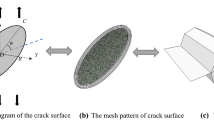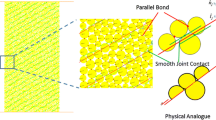Summary
An elastic stress-strain relation is formulated in terms of crack tensors which makes it possible to take into account explicitly the effect of joints on elastic behavior of rock masses. The present study is to discuss some related topics which may be encountered in its practical application. Two problems are solved by incorporating the elastic stress-strain relation into a program for three-dimensional finite element analyses; i. e., stress concentration by surface loading and displacement by excavation of an intersecting tunnel. Validity of the results is checked by comparing them with a laboratory model test and a field test, with the following conclusions: The overall distribution of stress definitely depends on a joint stiffness ratio (i. e., normal stiffness to shear stiffness). If the ratio is chosen as unity, the stress concentration occurs mainly in the direction parallel to major joints. If the ratio is high, say 10, then the stress concentrates along the perpendicular as well as the parallel directions to major joints. It can be said, on the basis of the fairly good agreement of the calculations using the high stiffness ratio with the field and laboratory measurements, that the elastic solution by crack tensors provides a practical tool for estimating the stress and strain in strongly jointed rock masses.
Similar content being viewed by others
References
Bandis, S., Lumsden, A. C., Barton, N. R. (1981): Experimental studies of scale effects on the shear behaviour of rock joints. Int. J. Rock Mech. Min. Sci. Geomech. Abstr. 18, 1–21.
Barton, N. R., Choubey, V. (1977): The shear strength of rock joint in theory and practice. Rock Mechanics 10 (1), 1–54.
Budiansky, B., O'Connell, R. J. (1976): Elastic moduli of a cracked solid. Int. J. Solids Structure 12, 81–97.
Gaziev, E. G., Erlikhman, S. A. (1971): Stresses and strains in anisotropic foundation (model studies). Symposium Soc. Internat. Mécaniques des Roches, Nancy, II-1.
Goodman, R. E., Duncan, J. M. (1971): The role of structure and solid mechanics in the design of surface and underground excavations in rock. In: Teèni, M. (ed.) Structure, solid mechanics and engineering design J. Wiley, New York, 1379–1404.
Goodman, R. E., Taylor, R. L., Brekke, L. (1968): A model for the mechanics of jointed rock. J. Soil Mech. Found. Div., Am. Soc. Civ. Eng. 94 (SM 3), 637–659.
Hamajima, R., Izeki, H., Okumura, T., Akiyama, N. (1980): Stress transfer mechanism of fissured foundation. Research Report of Dept. Found. Engng. Const. Engng. 9, Saitama University, 37–75.
Horri, H., Nemat-Nasser, S. (1983): Overall moduli of solids with microcracks: load induced anisotropy. J. Mech. Phys. Solids 31 (2), 155–171.
Ishizuka, Y., Saito, A. (in prep.): Characteristics of the disturbed zone surrounding the underground opening of jointed rock mass. In: Proc., Japan Society of Civil Engineering (to appear).
Krsmanović, D., Melić, S. (1964): Model experiments on pressure distribution in some cases of a discontinuum. Felsmechanik Ingenieurgeologie XIV, Suppl. I, 72–87.
Oda, M. (1988a): An experimental study of the elasticity of mylonite rock with random cracks. Int. J. Rock Mech. Min. Sci. Geomech. Abstr. 25 (2), 59–69.
Oda, M. (1988b): A method for evaluating the representative elementary volume based on joint survey of rock masses. Canadian Geotech. J. 25, 440–447.
Oda, M., Suzuki, K., Maeshibu, T. (1984): Elastic compliance for rock-like materials. Soils Founds. 24 (3), 27–40.
Pratt, H. R., Swolfs, H. S., Brace, W. F., Black, A. D., Handin, J. W. (1977): Elastic and transport properties of an in situ jointed granite. Int. J. Rock Mech. Min. Sci. Geomech. Abstr. 14, 35–45.
Singh, B. (1973): Continuum characterization of jointed rock masses. Int. J. Rock Mech. Min. Sci. Geomech. Abstr. 10, 311–335.
Walsh, J. B. (1965): The effect of cracks on the uniaxial elastic compression of rock. J. Geophys. Res. 70 (2), 399–411.
Yamabe, T., Hara, N., Oda, M. (1987): Parameter determination in elastic analysis of jointed rock masses by crack tensor theory. In: Proc., Japan Society of Civil Engineers 382 (III-7), 121–130.
Yoshinaka, R., Yamabe, T. (1986): Joint stiffness and the deformation behaviour of discontinuous rock. Int. J. Rock Mech. Min. Sci. Geomech. Abstr. 23 (1), 19–28.
Author information
Authors and Affiliations
Rights and permissions
About this article
Cite this article
Oda, M., Yamabe, T., Ishizuka, Y. et al. Elastic stress and strain in jointed rock masses by means of crack tensor analysis. Rock Mech Rock Engng 26, 89–112 (1993). https://doi.org/10.1007/BF01023618
Issue Date:
DOI: https://doi.org/10.1007/BF01023618




